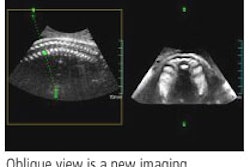The practice of obstetrics and gynecology (ob/gyn) ultrasound requires awareness of key legal implications, according to Dr. Louis Weinstein of Thomas Jefferson University Hospital in Philadelphia. He spoke during a presentation at the 2006 Leading Edge in Diagnostic Ultrasound conference in Atlantic City.
"Try and do (ob/gyn ultrasound) in the way that will offer the patient the best care she can get, and from your point of view, offer you the best of what you need so that liability issues won't come to the forefront," Weinstein said.
Technological advances have increased expectations of what patients want, what they have, and what they think is going to happen to them, he said. In addition, physicians and other healthcare providers give patients unrealistic expectations, partly because of the language they use.
"The only way we're ever going to solve the professional liability crisis in the U.S. is to improve patient safety and prevent medical errors," Weinstein said. "Tort reform clearly doesn't work and it never will work."
Of ultrasound liability cases, obstetric cases contribute 75%, gynecologic and abdominal each produce 10%, and breast studies produce 5% of the cases, he said.
In the cases that have been closed, 90% involve issues such as failure to perform the examination, faulty performance of a scan, "invented" lesions, a missed diagnosis, lack of communication, and informed consent, Weinstein said.
Ultrasound skills must be demonstrated, whether the studies are being handled by a radiologist, obstetrician/gynecologist, maternal fetal medicine physician, or an emergency room physician, he said.
"I don't mind who does the ultrasound," Weinstein said. "It's the quality of the person and it's the quality of the scan. It has nothing to do with what your specialty is as long as you've been properly trained."
The dilemma in this matter is weighing clinical acumen versus technical expertise, he said.
"Politics shouldn't play a role here. What should play a role is who's the physician who can do it the best?" Weinstein said. "And if he or she is a radiologist, then fantastic. If it's an ob/gyn doc or a maternal fetal medicine doc, then fantastic. To me, it's unlikely it's going to be an emergency room physician, because how can they have that level of expertise when they have so many other things to get in their training?"
By agency law, the technologist is the agent of the physician. It's illegal for a technologist to interpret a scan, he said.
"They can't make a diagnosis," Weinstein said. "They cannot give information to the patient."
As for informed consent, most states require that patients be informed of the significant risks of doing the test, of not doing the test, of what you found, and the possibility of what you didn't find but thought you would find, he said.
The legal definition of significance refers to the likelihood of occurrence and the seriousness of the risk, Weinstein said.
"We (as physicians) tend to talk too much, we tell patients things that (we) legally cannot support and cannot justify," he said.
The two big issues with obstetric litigation deal with prediction of normality and informed consent value, Weinstein said.
One common error seen in the legal arena deals with chronological dating.
"I can't stress enough to you, you cannot date the third-trimester fetus," he said. "You can give (the patient) a range of dates if you want to, but you can't date a pregnancy in the third trimester. Yet it's done all the time out in the real world."
Other common errors included a missed lesion, improper terminology, and inappropriate provision of a treatment plan, Weinstein said.
"Do not make treatment plans -- they're the kiss of death for you," he said. "Your job is to interpret the scan…. A treatment plan is a dangerous thing to put into an ultrasound report, unless you have that full level of training. If you don't have the clinical skills, don't put a treatment plan in."
The words count, so be very careful what terminology you use, Weinstein noted.
If the term "normal" was used in a report, that legally means that the baby was healthy, conformed to an accepted standard, has to be at least average, and has no detectable abnormality, he said. That's a tough standard to meet.
"No gross abnormalities noted" should be the term used on the ultrasound report, Weinstein said.
OB claims
Weinstein talked about several representative cases that have closed in recent years. In a 2000 case in New York involving a failure to diagnose abruption, the radiologist was not available. The technician did the scan but was unsupervised and said there was no abruption. This case showed clear deviation from standard, but the jury found no causation, however, he said.
In a 2001 Ohio case involving low amniotic fluid, a scan was performed at 41 weeks and was not documented. A stillbirth occurred six days later, and the physician testified that the amniotic fluid volume was normal. The jury apparently believed him and somehow found no causation, Weinstein said.
"This one was awfully lucky, because the law says if (the test is) not documented, it was not done," he said.
A 2000 Texas case involved a failure to communicate. The ultrasound was abnormal, but the physician was not advised of the findings. The baby was delivered, and had neurological issues. A $5.7 million verdict was turned in -- $1 million from the obstetrician and $4.7 million from the radiologists.
"The issue here was a system error," Weinstein said. "This was not (a case of) bad doctors. The ultrasound actually was read correctly, but there was no communication."
In another New York case in 2000 that resulted in a $10 million verdict, estimated fetal weight was 3300 grams at 39 weeks. The baby was delivered with Erb's palsy at 40.5 weeks at 5500 grams.
"People have to understand that estimating fetal weight by ultrasound is not an accurate reading, neither is it by physical exam," Weinstein said. "There is no good technique for determining fetal weight."
This case found for the patient purely based on the lack of informed consent, he said.
In a 2000 case in California, vasa previa was diagnosed in the third trimester. However, the finding was never communicated to the physician and the physician never read the report. The physicians ruptured the membranes, which led to severe damage to the infant. $1.3 million was awarded, split between the radiologist and physician.
In a 1996 case in Michigan that resulted in a $3.5 million verdict, an ultrasound diagnosis of fetal demise was made at term. No fetal monitoring was performed during birth, but the baby was born alive. The baby was depressed and mentally challenged.
"This is not an isolated event," Weinstein said. "I'm personally aware of six of these, and I'm sure there are others I have no idea about. It changes our management when we think the baby would be alive."
Some other representative claims include failure to diagnose: neural tube defect ($10.6 million, New York, 2000), increased nuchal fold ($1.7 million, New Jersey 2002), microcephaly ($2 million, New Jersey, 2002), ectopic pregnancy/death ($500,000 California 2000), and ectopic pregnancy/normal pregnancy ($1 million for radiologist/$235,000 for obstetrician, Georgia, 2002).
The whole focus today in ob/gyn is becoming prenatal diagnosis, and first-trimester screening can be one of the biggest legal traps you can get into, Weinstein said.
"Unless you are absolutely, absolutely convinced that you know exactly how to do this, this is the kiss of death," he said. "There have already been several cases of patients who have had terminations for an abnormal baby that was determined to be a Down's syndrome child by first-trimester screening that turned out to have a perfectly normal karyotype. And this is just the tip of the iceberg."
As first-trimester screening increasingly becomes the standard of care, these types of cases are going to become very prevalent in the next 12-24 months, he said.
Suggestions
To help users navigate this legal minefield, Weinstein offered a number of suggestions, including ensuring that ultrasound patients receive an informed consent form. This includes discussing uncertainties, the possibility of erroneous results, and the lack of perfection.
"Patients clearly have to know that none of us are perfect when it comes to ultrasound," he said.
He also suggests pursuing a centralized scanning approach, in which experts do all the ob/gyn scanning. For example, a city the size of Philadelphia could have three centers that handle the work.
All patients should have a scan between 16-20 weeks, and payment should be made by the number of patients, Weinstein said. All follow-up scans should be performed at no cost.
Finally, with reporting, don't use adverbs or adjectives, and eliminate the use of the term "normal," he said. And don't discuss treatment plans.
By Erik L. Ridley
AuntMinnie.com staff writer
July 13, 2006
Related Reading
Navigating PET/CT's logistical and legal issues, April 24, 2006
How the legal system stacks the deck against mammography, April 3, 2006
ACR member suspended for malpractice testimony, March 30, 2006
CAD results as evidence in Ohio trial may open door to future rulings, July 13, 2006
Mammography CAD: Getting malpractice insurers on board, October 21, 2005
Copyright © 2006 AuntMinnie.com



















